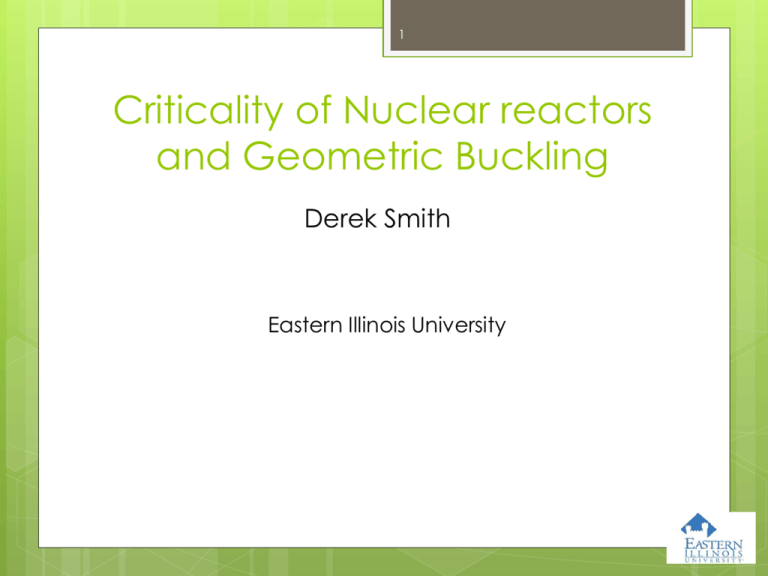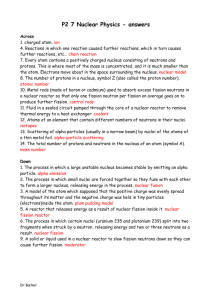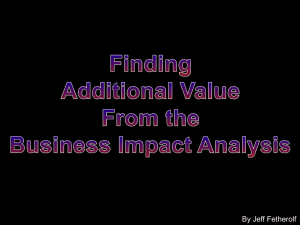
1
Criticality of Nuclear reactors
and Geometric Buckling
Derek Smith
Eastern Illinois University
2
How do you make Nuclear
energy safe?
1.
Understand a basic reactor.
3
http://www.cameco.com/uranium_101
/uranium_science/nuclear_reactors/
4
How to understand Nuclear
Energy
1.
Understand a basic reactor.
2. Understand how the control rods
maintain reactor criticality.
https://commons.wikime
dia.org/wiki/File:Control_r
ods_schematic.svg
5
Farther down= more neutrons absorbed & less heat
Farther up= less neutrons absorbed & higher heat
6
http://www.lanl.gov/quarterly
/q_fall03/reactor.shtml
7
8
How to understand Nuclear
Energy
1.
Understand a basic reactor.
2. Understand how the control rods
maintain reactor criticality.
3. what is criticality?
9
Criticality
Criticality may be defined as the
“attainment of physical conditions such that
a fissile material will sustain a chain
reaction”
Accidental criticality is the highest hazard a
health physicist deals with.
This can be maintained with efforts to
prevent accidental criticality with Criticality
control or Nuclear safety
10
Accidental criticality
U235
nucleus
Alpha
particle
11
Uncontrolled chain reaction:
from accidental criticality
12
Criticality
Subcritical- if more
neutrons are lost by
escape or nonfission
absorption than are
produced, and the
chain reaction isn’t
self sustaining and
dies out
Supercritical- a
sustained chain
reaction with the rate
of fission neutron
production exceed
the rate of loss
Critical- when exactly
one neutron per
fission is available for
initiating another
fission.
13
Sub-critical
14
Criticality
Subcritical- if more
neutrons are lost by
escape or nonfission
absorption than are
produced, and the
chain reaction isn’t
self sustaining and
dies out
Supercritical- a
sustained chain
reaction with the rate
of fission neutron
production exceed
the rate of loss
Critical- when exactly
one neutron per
fission is available for
initiating another
fission.
15
Super-Critical
16
Criticality
Subcritical- if more
neutrons are lost by
escape or nonfission
absorption than are
produced, and the
chain reaction isn’t
self sustaining and
dies out
Supercritical- a
sustained chain
reaction with the rate
of fission neutron
production exceed
the rate of loss
Critical- when exactly
one neutron per
fission is available for
initiating another
fission.
17
Critical
18
Criticality Control
1.
2.
3.
4.
5.
6.
7.
Accidental criticality depends on the following:
Quantity of the fissile material
Geometry of the fissile assembly
Presence or absence of a moderator
Presence or absence of a neutron reflector
Presence or absence of a strong neutron absorber
(poison)
Concentration of fissile material, if the fissile material is
in solution
Interaction between two or more assemblies or arrays
of fissile material, each one of which is subcritical by
itself. Consideration of this possibility is important in
the transport and storage of fissile materials.
Criticality control
19
Nuclear safety can be assured by limiting at least one of the
factors that determines criticality
1.
Mass control- limiting the mass of fissile material to less than the
critical mass under any conceivable condition
2.
Geometry control- having a geometric configuration that can
never become critical because the surface-to-volume ratio is
such that excessive neutron leakage makes it impossible to
attain a multiplication factor as great as 1.
3.
Concentration control- if the solution of fissile material is
sufficiently dilute, absorption of neutrons by the hydrogen atoms
makes a sustained chain reaction impossible. The degree of
enrichment of 235U is important to this control.
20
How to understand Nuclear
Energy
1.
Understand a basic reactor.
2. Understand how the control rods
maintain reactor criticality.
3. what is criticality?
4. Understanding Fission
21
Nuclear Fission: Uranium relation
Nuclei with odd numbers of nucleons are more easily fissioned
than those with an even number of nucleons. For example 235U
which fissions after capturing a thermal neutron,
U 01n
236
fission
92 U
235
92
Whereas 238U which can also capture a thermal neutron, is
transformed into an even-odd nucleus and rids itself of its
excitation energy by emitting a gamma ray
U 01n
239
92U
238
92
http://scienceblogs.
com/startswithaban
g/2009/04/is_uraniu
m_the_heaviest_nat
ura.php
22
Nuclear Fission: fission fragments
When an atom fissions, it splits into two fission fragments
plus several neutrons (the mean number of neutrons per
fission of 235U is 2.5) plus gamma rays according to the
conservation equation:
U
ZA11 F ZA22 F v01n Q
236
92
An approximate distribution of this energy is as follows:
Fission fragments, kinetic energy 167 MeV
Neutron kinetic energy
6
Fission gamma rays
6
Radioactive decay
Beta particle
5
Gamma rays
5
neutrinos
11
200 MeV
23
Nuclear Fission: Spontaneous fission
For the possibility of fission the
following mass- energy relationship
must hold:
E f (M m1 m2 mn )c 2
This condition can only be met by
isotopes whose atomic number and
atomic mass are such that: Z 2 / A 15
Although its likelihood is very small
spontaneous fission (can cause
accidental criticality) is very
important in criticality control.
If an isotope : Z 2 / A 49 the nucleus
is unstable toward fission and would
undergo spontaneous fission.
http://acadine.physics.jmu.edu/
main/phys215_transparencies/1
2.nuclear_fission/61_liquid_drop_
model.JPG
24
Uncontrolled chain reaction:
from accidental criticality
25
Nuclear Fission: Rate of Fission
Most of the energy dissipated in the critical
assembly is heat energy. Using a mean value of
190 MeV (million- electron volts) heat energy per
fission, the rate of fission to generate one watt of
power is calculated as follows:
fiss
MeV
J
W
190
1.6 10 13
1
J
s
fiss
MeV
s
fiss
X 3.3 1010
s
1W X
26
How to understand Nuclear
Energy
1.
Understand a basic reactor.
2. Understand how the control rods
maintain reactor criticality.
3. what is criticality?
4. Understanding Fission
5.Putting a value on criticality
27
Multiplication factor: The FourFactor Formula
Criticality,
also known as the value of Keff
depends on the supply of neutrons of
proper energy to initiate fission and also
on the availability of fissile atoms.
when :
keff 1.0000 subcritica l system
keff 1.0000 supercriti cal system
keff 1.0000 critical system
28
FOUR FACTOR FORMULA: INFINITE
MULTIPLICATION FACTOR
k
N f 1
Nf
n pf
pf
n
•ηis the mean number of neutrons emitted per absorption of
Uranium, so n thermal neutrons will result in ηn fission neutrons.
•Є=fast fission factor with max value= 1.29
•p=Resonance capture is called Resonance escape probability or
p and is defined as the fraction of the fast, fission produced
neutrons that finally become thermalized. The value of p depends
on the ratio of moderator to fuel.
•f=The fraction of the total number of thermalized neutrons
absorbed by the fuel (including all the uranium) is called the
thermal utilization factor, f
29
Reactivity and Reactor
Control
Increase in the neutron multiplication factor
>1 is called excess reactivity, defined by:
k k 1
For n neutrons in one generation, we have
additional neutrons in succeeding
generation. The time rate of change of
neutrons is: nk
d n n k
dt
l
, l is the lifetime of the neutron
generation
30
Reactivity and Reactor
Control
0.001s is the mean lifetime of a neutron from
its birth to its absorption in pure 235U
When the excess reactivity is 0.1%, that is ∆k =
0.001, the reactor period is: T=0.001/0.001= 1s
and the power level increases by a factor of
e, or 2.718 each second.
If ∆k were increased to 5% then: T=
0.001/0.005= 0.2s ,and the power lever
increases in 1s would be by a factor of 150.
31
How to understand Nuclear
Energy
1.
Understand a basic reactor.
2. Understand how the control rods
maintain reactor criticality.
3. what is criticality?
4. Understanding Fission
5.Putting a value on criticality
6.Multiplying medium
Reactor Physics
Multiplying Medium
A multiplying medium is one in which
fission, either thermal or fast or both, does
occur.
a = absorption
f = fission
both terms have the same mathematical
form cross section times a flux
33
How to understand Nuclear
Energy
1.
Understand a basic reactor.
2. Understand how the control rods
maintain reactor criticality.
3. what is criticality?
4. Understanding Fission
5.Putting a value on criticality
6.Multiplying medium
7. Buckling
Bare Slab Reactor
a
2
( d) (
a
d) 0 =
2
flux boundaries
Center line x
y
X
Z
Extrapolation distance (d)
(-a/2-d)
-a/2
0
a/2
(a/2+d)
Buckling
The neutron diffusion equation for the bare slab reactor can be
written as would be:
d 2
2
B
1 0
2
dx
in which B1 is called Buckling. Buckling is the measurement of
extent to which the flux curves or "buckles".
buckling can be used to infer leakage. The greater the
curvature the more leakage expected. For critical reactivity the
material buckling should be equal to geometrical buckling.
Hence reactivity can be controlled with proper buckling
incorporated in reactor’ s design.
36
How to understand Nuclear
Energy
1. Understand a basic reactor.
2. Understand how the control rods maintain
reactor criticality.
3. what is criticality?
4. Understanding Fission
5.Putting a value on criticality
6.Multiplying medium
7. Buckling
8. Determination of reactor’s critical
dimension
37
Reactor’s critical dimension
•Rearranging the Buckling equation we get:
B 2m
K 1
M2
R
ex
2
•We can then solve for Rex
38
Sources
Ferguson, C. D. (2011). Nuclear Energy- what everyone
needs to know. New York, New York: Oxford University Press,
Inc.
Cotton, S. (n.d.). Uranium Hexafluoride - UF6. Retrieved
February 26, 2012, from chm.bris.ac.uk:
www.chm.bris.ac.uk/motm/uf6/uf6v.htm
Hewitt, P. G. (2006). Conceptual Physics 10th edition. St.
Petersburg: Pearson-Addison Wesley.
Moniz, E. (2011). Why We Still Need Nuclear Power. Foreign
Affairs , 83-94.
Nuclearfiles.org. (n.d.). from nuclear proliferation to
nuclear testing. Retrieved February 25, 2012, from
Nuclearfiles: project of the nuclear age peace foundation:
http://www.nuclearfiles.org/?gclid=CN2AvL3vyK4CFQzGKg
od62OzBg








